roof Citroen DS4 2012 1.G Owner's Manual
[x] Cancel search | Manufacturer: CITROEN, Model Year: 2012, Model line: DS4, Model: Citroen DS4 2012 1.GPages: 396, PDF Size: 12.14 MB
Page 7 of 396
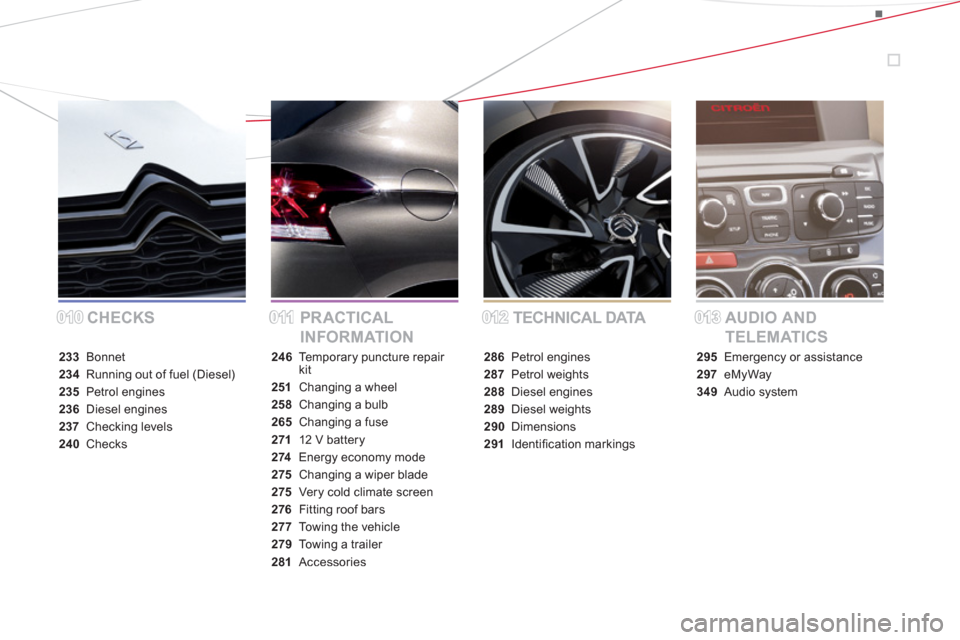
CHECKS PRACTICAL
INFORMATIONTECHNICAL DATA AUDIO AND
TELEMATICS
233 Bonnet
234Running out of fuel (Diesel)
235Petrol engines
236 Diesel engines
237 Checking levels
240 Checks
246Te m p o r a ry puncture repair
kit
251 Changing a wheel
258 Changing a bulb
265Changing a fuse
271 12 V battery
274 Energy economy mode
275Changing a wiper blade
275Very cold climate screen
276Fitting roof bars
277 Towing the vehicle
279To w i ng a trailer
281 Accessories
286 Petrol engines
287 Petrol weights
288Diesel engines
289Diesel weights
290Dimensions
291Identifi cation markings
295 Emergency or assistance
297 eMyWay
349 Audio system
012012013013010010011011
Page 18 of 396
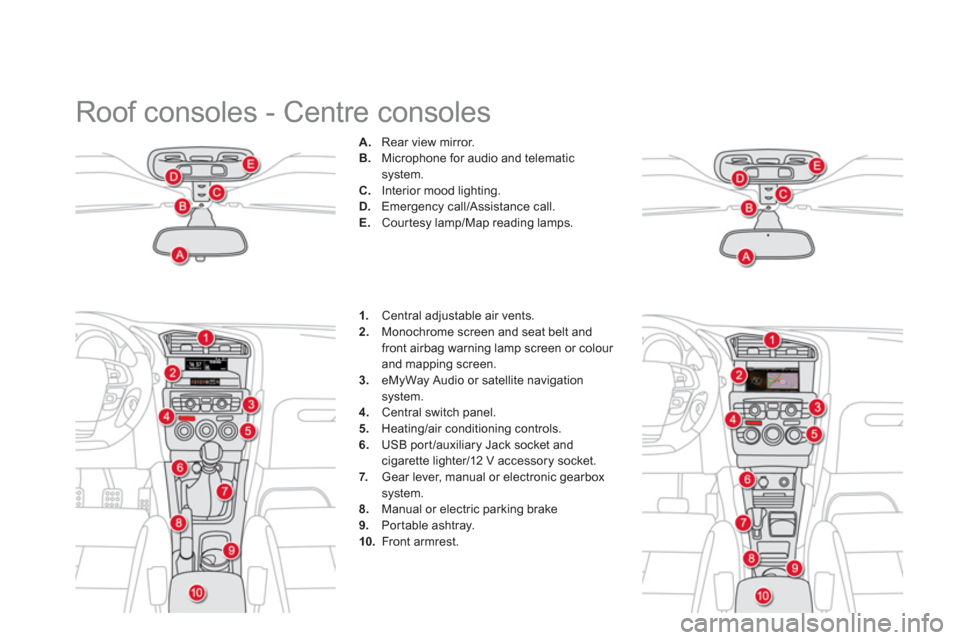
Roof consoles - Centre consoles
A.
Rear view mirror.
B
. Microphone for audio and telematic system.C.
Interior mood lighting.D.Emergency call/Assistance call. E.Courtesy lamp/Map reading lamps.
1
.Central adjustable air vents. 2. Monochrome screen and seat belt and front airbag warning lamp screen or colour
and mapping screen. 3. eMyWay Audio or satellite navigationsystem.4.Central switch panel.
5.Heating/air conditioning controls.
6. USB port/auxiliary Jack socket and cigarette lighter/12 V accessory socket. 7.Gear lever, manual or electronic gearboxsystem.8.
Manual or electric parking brake9.Portable ashtray.
10. Front armrest.
Page 36 of 396
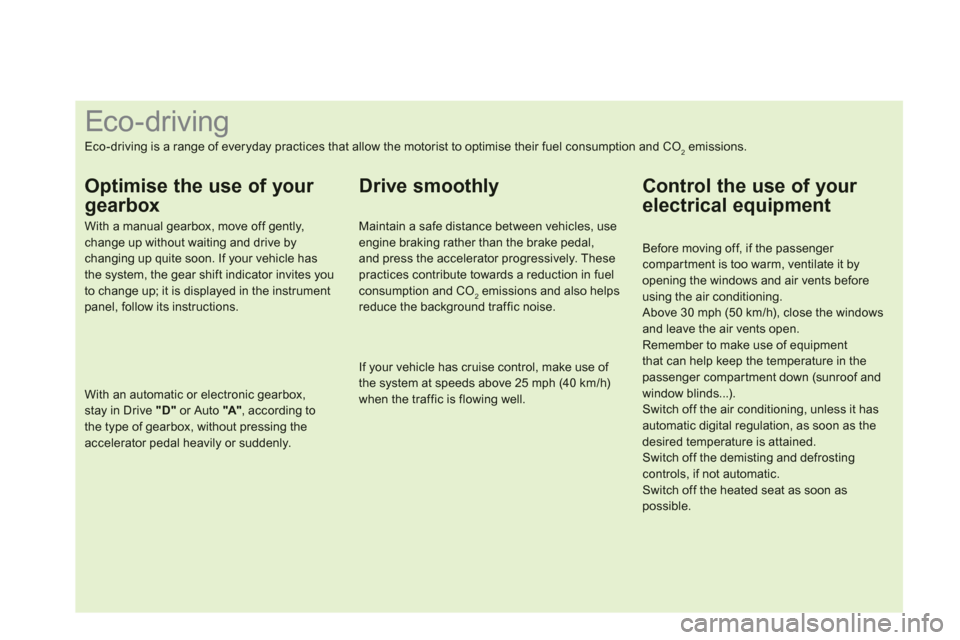
Eco-driving
Eco-driving is a range of everyday practices that allow the motorist to optimise their fuel consumption and CO2emissions.
Optimise the use of your
gearbox
With a manual gearbox, move off gently,change up without waiting and drive by changing up quite soon. If your vehicle has the system, the gear shift indicator invites youto change up; it is displayed in the instrumentpanel, follow its instructions.
With an automatic or electronic gearbox, stay in Drive "D"or Auto "A"
, according to the type of gearbox, without pressing theaccelerator pedal heavily or suddenly.
Drive smoothly
Maintain a safe distance between vehicles, use engine braking rather than the brake pedal, and press the accelerator progressively. These practices contribute towards a reduction in fuel consumption and CO2emissions and also helpsreduce the background traffic noise.
If your vehicle has cruise control, make use of the system at speeds above 25 mph (40 km/h) when the traffic is flowing well.
Control the use of your
electrical equipment
Before moving off, if the passenger compartment is too warm, ventilate it by opening the windows and air vents before using the air conditioning. Above 30 mph (50 km/h), close the windowsand leave the air vents open.
Remember to make use of equipment that can help keep the temperature in thepassenger compar tment down (sunroof and window blinds...). Switch off the air conditioning, unless it hasautomatic digital regulation, as soon as the desired temperature is attained.
Switch off the demisting and defrosting controls, if not automatic. Switch off the heated seat as soon as possible.
Page 37 of 396
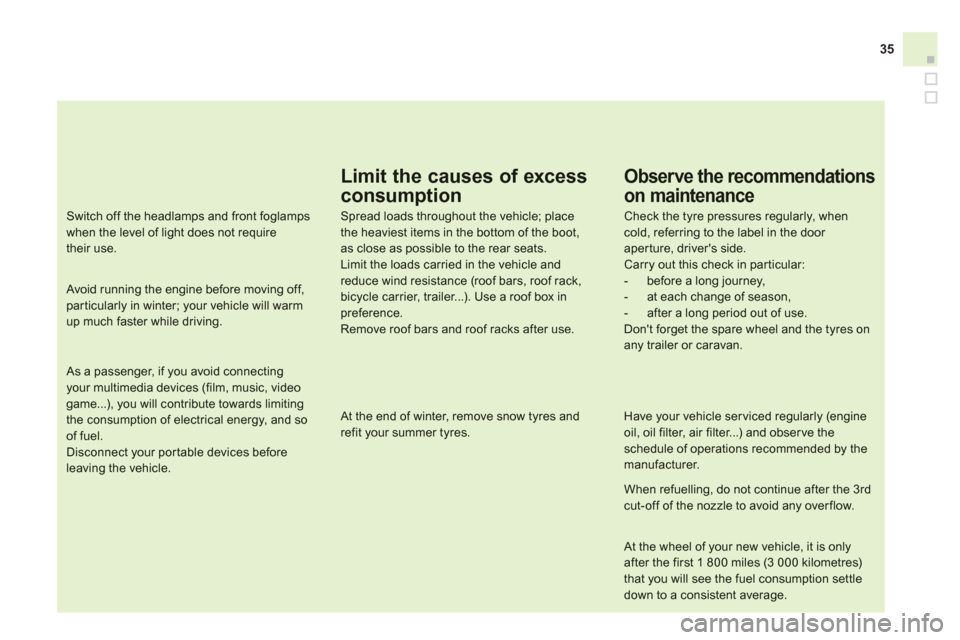
35
Limit the causes of excess
consumption
Spread loads throughout the vehicle; placethe heaviest items in the bottom of the boot, as close as possible to the rear seats. Limit the loads carried in the vehicle andreduce wind resistance (roof bars, roof rack,bicycle carrier, trailer...). Use a roof box in preference. Remove roof bars and roof racks after use.
At the end of winter, remove snow tyres andrefit your summer tyres.
Observe the recommendations
on maintenance
Check the tyre pressures regularly, whencold, referring to the label in the door aperture, driver's side.
Carry out this check in par ticular:
- before a long journey,
- at each change of season,
- after a long period out of use.
Don't forget the spare wheel and the tyres on any trailer or caravan.
Have your vehicle ser viced regularly (engineoil, oil filter, air filter...) and obser ve theschedule of operations recommended by the manufacturer.
When refuelling, do not continue after the 3 rdcut-off of the nozzle to avoid any overflow.
At the wheel of your new vehicle, it is only after the first 1 800 miles (3 000 kilometres) that you will see the fuel consumption settledown to a consistent average.
Switch off the headlamps and front foglamps when the level of light does not require their use.
Avoid running the engine before moving off,particularly in winter; your vehicle will warmup much faster while driving.
As a passenger, if you avoid connecting your multimedia devices (film, music, videogame...), you will contribute towards limitingthe consumption of electrical energy, and soof fuel. Disconnect your por table devices beforeleaving the vehicle.
Page 48 of 396
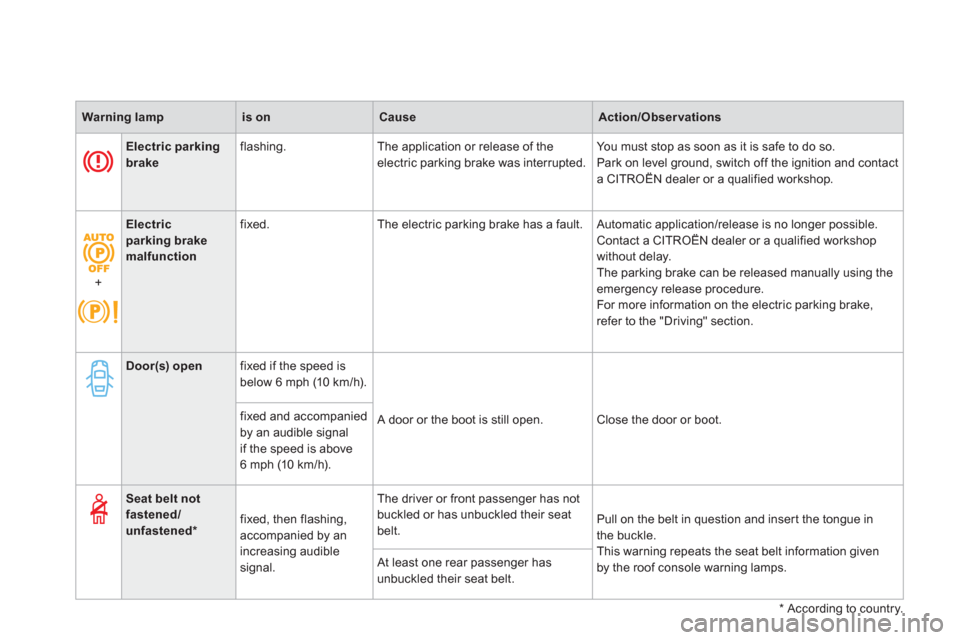
Warning lampis onCauseAction/Observations
Electric parkingbrake flashing. The application or release of theelectric parking brake was interrupted. You must stop as soon as it is safe to do so.
Park on level ground, switch off the ignition and contact
a CITROËN dealer or a qualified workshop.
+
Electric parking brakemalfunction
fix
ed. The electric parking brake has a fault. Automatic application/release is no longer possible.
Contact a CITROËN dealer or a qualified workshop
without dela
y.
The parking brake can be released manually using theemergency release procedure.
For more information on the electric parking brake,refer to the "Driving" section.
Door(s) open
fixed if the speed isbelow 6 mph (10 km/h).
A door or the boot is still open.
Close the door or boot.
fixed and accompanied by an audible signal
if the speed is above6 mph (10 km/h).
* Accordin
g to country.
Seat belt notfastened/unfastened * fixed, then flashing,
accompanied by anincreasing audible
signal. The driver or
front passenger has notbuckled or has unbuckled their seatbelt. Pull on the belt in question and inser t the tongue in
the buckle.
This warning repeats the seat belt information given by the roof console warning lamps. At least one rear passenger hasunbuckled their seat belt.
Page 141 of 396

Visibility
Interior mood lighting The dimmed passenger compar tment lighting improves visibility in the vehicle whenthe light is poor.
At night, the audio system and digital air conditioning illumination, together with the
illumination of the central dashboard storagebox, comes on automatically when the sidelamps are on. The interior mood li
ghting switches off
automatically when the sidelamps areswitched off.
It can be switched off manually by adjusting theinstrument panel lighting dimmer button to one of the lowest settings.
On cer tain versions, three LEDs, located in the rail linking the rear view mirror to the roof come on as well.
Switching on
Switching off
Page 192 of 396
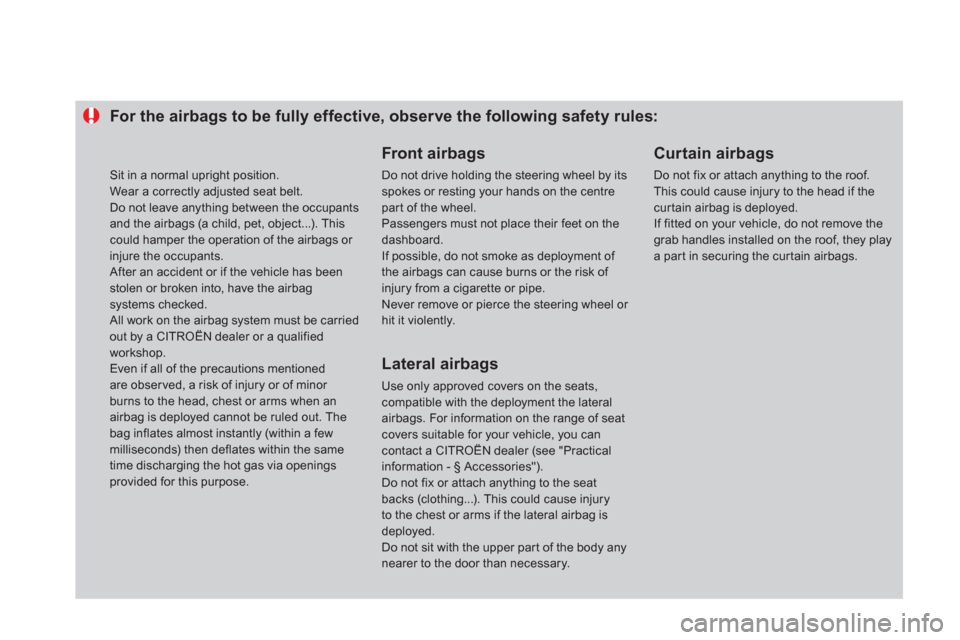
For the airbags to be fully effective, observe the following safety rules:
Front airbags
Do not drive holding the steering wheel by its spokes or resting your hands on the centre par t of the wheel.
Passengers must not place their feet on thedashboard.
If possible, do not smoke as deployment of the airbags can cause burns or the risk of injury from a cigarette or pipe.
Never remove or pierce the steering wheel or hit it violently.
Lateral airbags
Use only approved covers on the seats,compatible with the deployment the lateral airbags. For information on the range of seat covers suitable for your vehicle, you cancontact a CITROËN dealer (see "Practicalinformation - § Accessories").
Do not fix or attach anything to the seat backs (clothing...). This could cause injury to the chest or arms if the lateral airbag isdeployed.
Do not sit with the upper par t of the body any nearer to the door than necessary.
Curtain airbags
Do not fix or attach anything to the roof. This could cause injury to the head if thecurtain airbag is deployed.
If fitted on your vehicle, do not remove the grab handles installed on the roof, they play a par t in securing the cur tain airbags.
Sit in a normal upright position.
Wear a correctly adjusted seat belt.
Do not leave anything between the occupantsand the airbags (a child, pet, object...). This could hamper the operation of the airbags or injure the occupants. After an accident or if the vehicle has beenstolen or broken into, have the airbagsystems checked. All work on the airbag system must be carriedout by a CITROËN dealer or a qualified workshop.
Even if all of the precautions mentioned are obser ved, a risk of injury or of minor burns to the head, chest or arms when an airbag is deployed cannot be ruled out. The
bag inflates almost instantly (within a few milliseconds) then deflates within the sametime discharging the hot gas via openings provided for this purpose.
Page 278 of 396
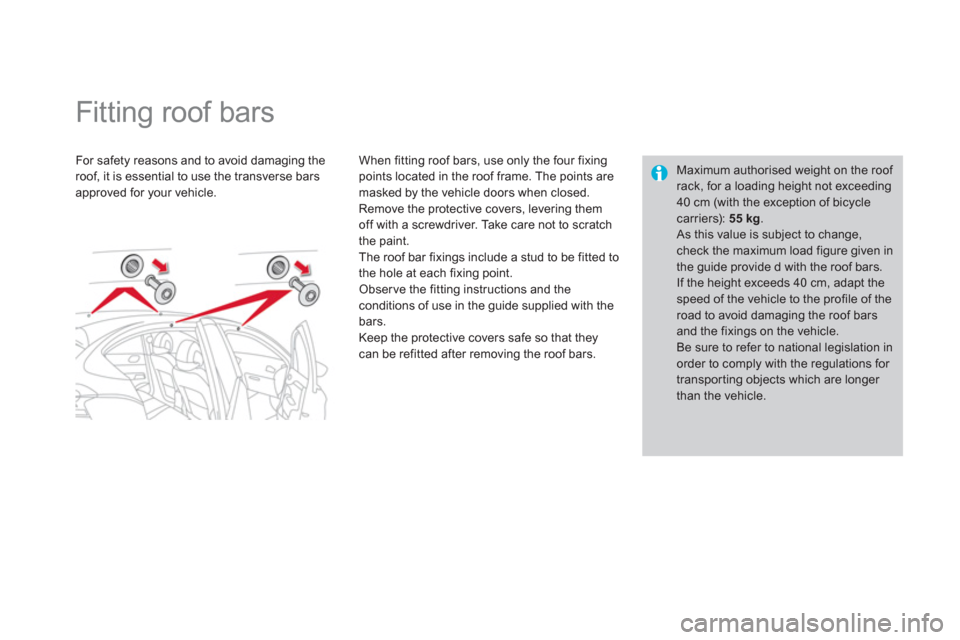
Fitting roof bars
For safety reasons and to avoid damaging the roof, it is essential to use the transverse barsapproved for your vehicle.
When
fitting roof bars, use only the four fixing points located in the roof frame. The points are
masked by the vehicle doors when closed.
Remove the protective covers, levering them
off with a screwdriver. Take care not to scratch
the paint.
The roof bar fixin
gs include a stud to be fitted to
the hole at each fixing point.
Observe the fitting instructions and theconditions of use in the guide supplied with the bars.
Keep the protective covers safe so that theycan be refitted after removing the roof bars.
Maximum authorised weight on the roof rack, for a loading height not exceeding40 cm (with the exception of bicycle
carriers): 55kg. As this value is subject to change, check the maximum load figure given inthe guide provide d with the roof bars.
If the height exceeds 40 cm, adapt thespeed of the vehicle to the profile of theroad to avoid damaging the roof bars and the fixings on the vehicle.
Be sure to refer to national legislation in order to comply with the regulations for transporting objects which are longer than the vehicle.
Page 283 of 396

281Practical information
Accessories A wide range of accessories and genuine par ts is available from the CITROËN dealer network.
These accessories and par ts have been tested and approved for reliability and safety.
They are all adapted to your vehicle and benefit from CITROËN's recommendation and warranty.
"Comfort":
door deflectors, side window blinds, rear screen blind, isotherm module, coat hanger fixed to head restraint, mobile reading lamp, mirror for caravan, parking sensors...
"Transport systems":
child seats and booster cushions, boot carpet,
boot liner, boot net, boot spacers, transverse
roof bars, bic
ycle carrier, ski carrier, roof boxes,
towbars, wiring harnesses...
"Styling":
gear lever knobs, aluminium foot rest, alloy wheels, chrome mirror shells, chrome door aperture finishers...
"Security and safety":
anti-intrusion alarm, anti-tilt unit, stolen
vehicle tracking system, child seats and
booster cushions, breathalyser, first aid kit, fire
extinguisher, warning triangle, high visibility
vest, wheel security bolts, snow chains,non-slip covers...
If a towbar and wiring harness are fittedoutside the CITROËN dealer network, the installation must be done followingthe manufacturer's recommendations.
* To avoid an
y risk of jamming the pedals:
- ensure that mats are correctl
y positionedand secured,
- never fit one mat on top of another.
"Protection":
mats *
, seat covers compatible with lateral
airbags, mud flaps, door protective mouldings,
bumper protection strips, vehicle cover...
Page 384 of 396
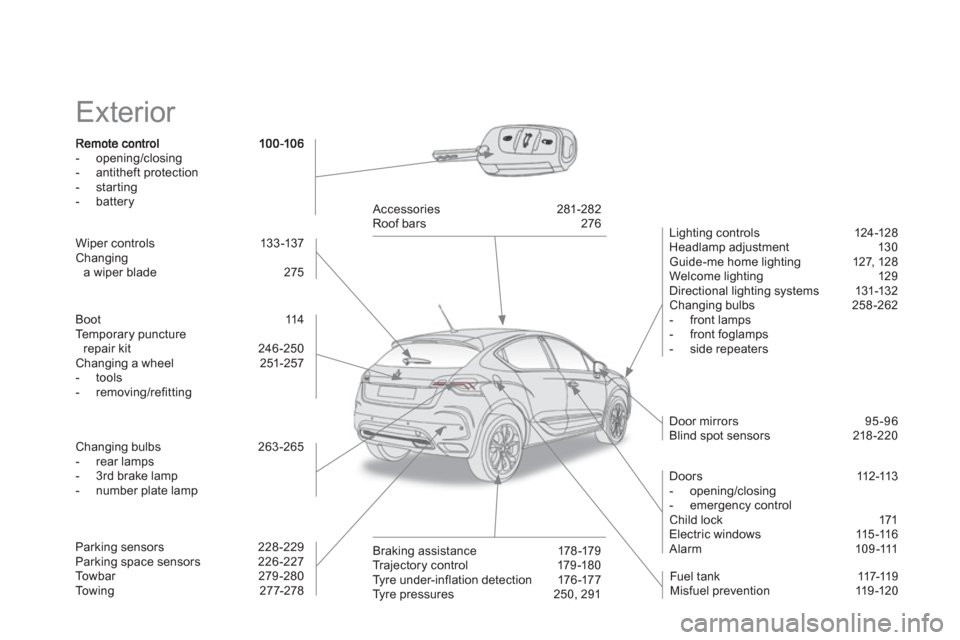
Exterior
- opening/closing
- antitheft protection
- starting
- battery
Lighting controls 124-128
Headlamp adjustment 130
Guide-me home lighting 127, 128
Welcome lighting 129
Directional lighting systems 131-132
Changing bulbs 258 -262
- front lamps
- front foglamps
- side repeaters Wiper controls
13 3-137
Changing
a wiper blade 275
D
oor mirrors 95-96
Blind spot sensors 218 -220
Doors
112-113
- opening/closing
- emergency control
Child lock 171
Electric windows 115-11 6
Alarm 109-111
Fuel tank 117-11 9
Misfuel prevention 119-120
Accessories
281-282
Roof bars 276
Brakin
g assistance 178-179
Tr ajectory control 179 -180
Tyre under-infl at i o n d ete c t i o n 176 -17 7
Tyre pressures 250, 291 B
oot 114
Te m p o r a ry puncture repair kit 246-250
Changing a wheel 251-257
- tools- removing/refitting
Chan
ging bulbs 263 -265
- rear lamps
- 3rd brake lamp
- number plate lamp
Parking sensors 228 -229
Parking space sensors 226 -227
To w b a r 2 7 9 - 2 8 0
Towing 277-278